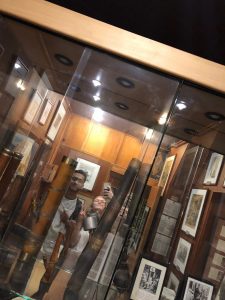This week I had the opportunity of visiting the Museé de Fumeur. While the front of the shop was unassuming, behind the quaint smoke shop lay a hallway and rooms filled with the historical documentation of smoking. In Paris, it had shocked me how socially pervasive smoking culture was. It often felt as though I couldn’t go five steps without breathing in second-hand smoke. The difference in the acceptability and prevalence of smoking in the US and France had intrigued me. The museum was fascinating as it helped me see how different cultures throughout time saw smoking and how smoking culture evolved. The coolest part of the museum, for me, was the collection of old smoking pipes. Each was ornately crafted and decorated, turning the pipe into a beautiful and artful piece instead of just a smoking device. I thought the intricate craftsmanship of each pipe was a measure of smoking’s high social value. In fact, the museum’s collection of portraits of famous people illustrated smoking as a form of expression, an accessory that could impact one’s identity and how they are viewed in society.








